BIOT Science Expedition 2014 - Stalking mantas and swimming with sharks - Day 18
Talking mantas and swimming with sharks
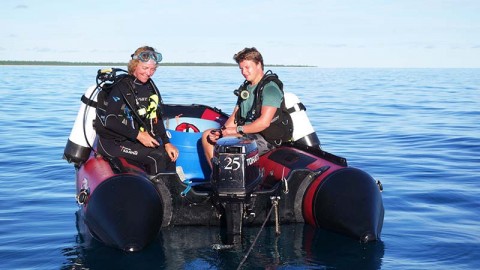
Today was a day for large pelagics. There was not a breath of wind this morning and the sea around the BIOT Research Vessel was flat calm and inviting. Perfect conditions for the wrap up day in the outer islands of the Chagos Archipelago. Visibility underwater was phenomenal making sharks easy to spot and there were a lot of them on the steep reef wall that we dropped in on.

Turtles, rays and mantas added themselves into the mix while on the shallower reef top the rubble and bedrock offered nooks and crannies for plenty of octopus to peer from with curiosity.
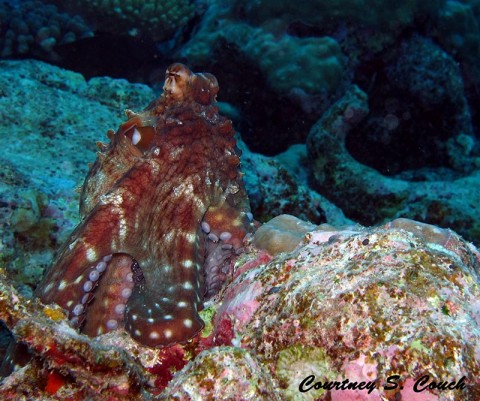
In these quality surrounds the morning’s data collection went ahead at various dive sites around the reefs of the atoll. But the afternoon offered up a new opportunity as David set himself to deploy some satellite tags.
“Today we woke up to find that the water was a flat as a pond and the sun was shining brightly. This made for perfect manta tagging conditions. Myself, Jon, Sophie and Pete set off after lunch on the hunt for mantas feeding in the lagoon. Several transects were completed with no sign of a single manta despite a green turtle doing its best manta impression. However, our luck would soon change. On our final transect we came across a group of 5/6 mantas feeding in the middle of the lagoon. Jon positioned the boat carefully ahead of the group so I could cut them off. The first time I approached the mantas turned on the side exposing their ventral side. Not an ideal location for tagging. I could see the dorsal side on my second attempt but for the manta to make a swift exit as I approached. The third attempt was a far stealthier affair. This time I came at the manta from behind, and undetected, positioned myself above the 2 metre ray and successfully deployed the tag. A bull’s-eye, perfectly placed! And a second successful deployment soon followed. After the second manta was tagged the group had dispersed so we headed back to the ship. It was great to tag two of these ocean giants but we now have an anxious three month wait to get the data back. Where will they go? We will see!”
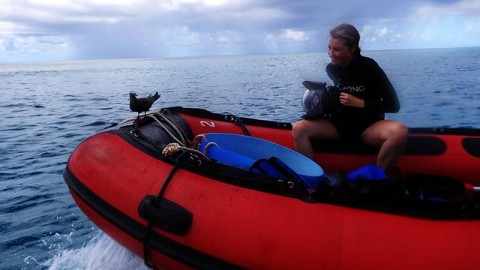
Unfortunately we didn’t get any pictures whilst tagging the mantas as we were all focused on the task at hand but we were entertained by a friendly common noddy tern as we motored back to the BIOT Research Vessel. At first he landed on Pete’s hand before trying my head for a perch and then dropping in front of Sophie as shown below.
As per usual while we were getting underwater Pete was on his way ashore to continue his terrestrial studies. His work in the outer islands on this expedition is done and he offers some insights on his findings below.
“After surveying eleven of the twelve designated and proposed Important Bird Area (IBA) islands and a number of other (rat-infested) islands, what can be said about the breeding seabirds of the Chagos after this expedition? First, let us look at the context of the results. What these scientific research expeditions achieve for bird monitoring is to provide a snap-shot of what breeding is occurring at that time. In the Chagos they do not provide a definitive figure for the annual breeding populations, as they would in a northern hemisphere environment where there is a defined breeding season and the entire breeding population can be surveyed. Further, the lack of regular long-term monitoring (including at different times of the year) means that what data is gathered cannot be fully interpreted in a population trend context. This is because we do not know, for example, how often complete breeding failures as happened this trip with Sooty Tern, actually occur. With those caveats in mind, a brief summary of the results of the more numerous breeding species follows:
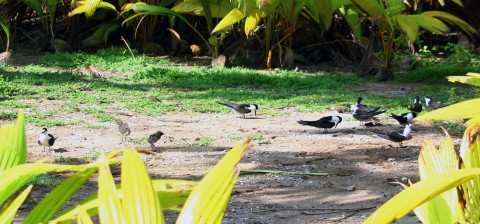
Sooty Tern: This species has had a catastrophic breeding season. This should be the most numerous breeding seabird and over 100,000 breeding pairs is the expected norm on four to six islands. This year less than 1,000 pairs bred on two islands. On Parasol in Peros Banhos 26% of chicks examined held ticks and the main colony of approximately 32,000 pairs deserted at the egg-laying stage. On Middle Brother, the previous survey in 2012 recorded 32,000 breeding pairs. This year there were less than 500 pairs and these were also tick-infested. What is not known is, is this a “normal,” periodic phenomena or a one-off event possibly leading to an overall decline in numbers? Collaboration with colleagues working on this species in the western Indian Ocean may answer this question.
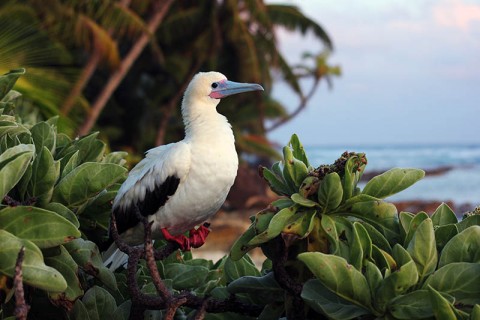
Red-footed Booby: This species appears to be holding its own. The three largest breeding colonies (3,000+) are on Nelson’s and Danger Island and Diego Garcia. Diego Garcia will not be surveyed on this trip as it takes at least five days to cover all the breeding area. To further complicate the surveying, the birds in the northern atolls start breeding earlier than those on the southern atolls. On Peros Banhos and the Solomons breeding was well underway and 95% of nests checked in these atolls held chicks that were between one and two months old. Further south on Danger Island and the Egmont’s all nest bar one were at the egg-laying stage. Previous surveys I have undertaken on Diego Garcia tell me that breeding there will not get fully underway until May. And then, to complicate the assessment further, small numbers of this species breed throughout the year!
Brown Booby: This beautiful bird produced a record count of over 700 breeding pairs on North Brother, the majority at the egg-laying stage. There is one other large colony in the Chagos, on Danger Island. This colony only held 38 breeding pairs but, these were all at the fledgling stage! With several recently fledged juveniles in the air around the northern point of the island, it was obvious I had missed the main breeding period. So, it is difficult to make a true comparison but it appears this species is doing well and may be expanding its breeding range with a nest being found on Ile Longue, Peros Banhos.
Lesser Noddy: This species also appears to be sustaining its breeding population in the Chagos but has historically proven problematical to survey due to an erratic breeding season. Counts throughout the year since 2008 have revealed an annual breeding population in the region of 35,000 – 40,000 pairs centred upon three major colonies on Nelson’s Island, South Brother and Petite Ile Bois Mangue and smaller colonies on many other islands. This year’s survey has coincided with breeding in these three main colonies and the total recorded has been comfortably above 35,000 pairs.
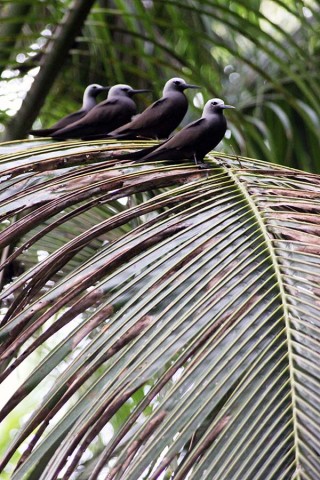
Common Noddy: This species continues to be of grave concern in the Chagos. In the 1970’s, Nelson’s and Danger Island and Sea Cow held terrestrial breeding populations of 10,000+. These numbers had declined to the low thousands by 1996 and terrestrial breeding had all but ceased by 2006. This situation has not changed and the annual breeding population has remained at under 5000 pairs. Crucially, this species no longer breeds in dense colonies on the ground. It now breeds in isolation in trees. Whilst still common, the population is likely to be in decline but has not manifested itself yet due to longevity.
Conclusion: A season of highs and lows. The take-away point is if we are serious about conserving birds (and other terrestrial organisms) in the Chagos we have to understand their ecology, part of which is their breeding phenology. This aspiration is still a long way off and can only be achieved by regular surveys throughout the year over a long period of time. Only by knowing such simple things as when and where a seabird breeds, how often and in what numbers, what on islands is impacting their breeding and most important, what oceanographic events trigger breeding, will we really be able to implement effective conservation management plans. Sadly, time may be running out for effective conservation measures in the Chagos for Common Noddy and Sooty Terns.”

